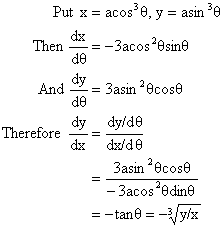differentiation-4
5) ![]()
Proof:
Let f(x) = sinx then,

Hence, ![]()
6) ![]()
7) ![]()
8) ![]()
9) ![]()
10) ![]() Why?
Why?
Proof:
Let f(x) = secx

Hence, ![]()
11) ![]()
Proof:
Let ![]() then x = siny.
then x = siny.
Differentiating w.r.t x we get,

Hence, ![]()
12) ![]()
13) ![]()
14) ![]()
15) ![]()
16) ![]() Why?
Why?
Proof:
Let y = sec-1x then secy = x.
Differentiating w.r.t x we have,

Hence, ![]()
Dumb Question:
Why ![]() and not
and not ![]() ?
?
Ans:

Fig (4)
Note that y = sec-1x is an increasing function in its domain.
So, ![]()
Illustration 6:
Differentiate ![]()
Solution:

Different Methods of Differentiation:
1) Differentiation of a function defined parametrically:
Let x, y be function of parameter t, i.e.
x = f (t), y = f (t) then,

Illustration:
![]()
Solution:

2) Logarithmic Differentiation:
The process of taking logarithm on both sides and then differentiating is called logarithmic differentiation.
Illustration 8:
Differentiate ![]() w.r.t x.
w.r.t x.
Solution:
Let y = ![]() .
.
Taking logarithm on both sides, then we have
logy = sinx.logx

3) Differentiation of Implicit function:
If the relation between x and y is given by equation containing both and this equation is not immediately solvable for y, then y is called implicit function of x.
Illustration 9:
If ![]() Then prove that
Then prove that ![]()
Solution:
Given that ![]() differentiating on both sides w.r.t x we have,
differentiating on both sides w.r.t x we have,

Hence, ![]()